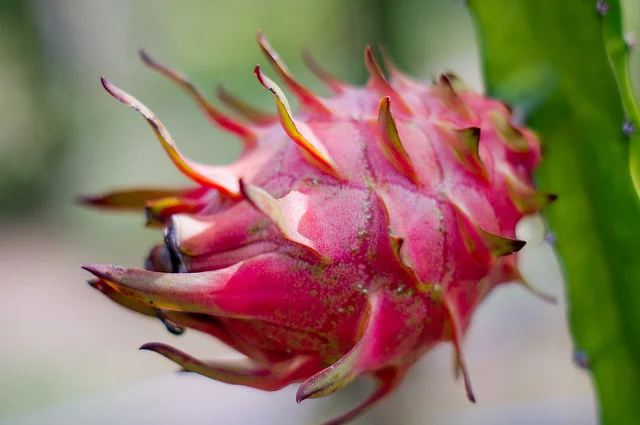dragon fruit
The sweet, red-fleshed fruit of several cactus species. Also known as pitahaya, pitaya or strawberry pears.
Scientific name: Hylocereus undatus.
Colloquially, the dragonfruit is also called green dragon, dragon pearl fruit, or dragon crystal fruit. Its fragrant flowers, which only bloom at night, earn the quirky names of ‘night blooming cereus’, 'moonflower’ and 'queen of the night’.
According to the Philippine Bureau of Agricultural Research (BAR), the dragon fruit plant matures within a year and starts to bear fruit around the same time, with an average of 5–6 cycles of harvest each year.
“The football-shaped dragon fruit weighs an average of 150–600 grams [ranging in size from a softball to a large grapefruit] with its outer skin either red or yellow in colour, depending on its variety,” reports Zueleen Reynoso in a BAR newsletter digest titled Enter the Dragon Fruit. “The flesh of the dragon fruit is white with tiny black edible seeds, with a texture much like that of a kiwi—soft, juicy, and a bit grainy, with a sweet-citrusy taste.”
Along with pomegranates and acai berries, dragon fruit has caught the interest of North American marketers as a candidate up for the label of “superfruit” - one serving provides 15% of an adult’s recommended daily intake of vitamin C along with high levels of potassium, iron and calcium. Among the fruit’s touted benefits, according to a Bloomberg Business report, is that “it’s full of phytoalbumin, an antioxidant believed to prevent the formation of cancer-causing free radicals.” David Wolfe, author of Superfoods, it continues, says it’s “one of my favourite fruits of all time.”
"At the farm, the hands-on dragon fruit lady farmer observes zero-waste management farming," says Leilanie Adriano, on site at Edita Dacuycuy’s farm in Burgos, Ilocos Norte.
On a blisteringly cold late February morning, at my local Loblaws grocery store in Toronto, I came across fresh dragon fruit in the produce aisle - bright red, spiky fat orbs of sweet fruit, which I instantly craved sinking my teeth into. I remembered reading an article called “Dragon fruit takes over Ilocos Norte” from the Philippine Inquirer not long ago, and it got me thinking - how much did I know about dragon fruit?
I fell into pages of reading.
Learn more:
• Dragon fruit harvests in the Philippines - and promoting farms as an agricultural tourism destination
• To produce fruit, hylocereus undatus needs long days of sunlight. The Ilocos Agriculture and Resources Research and Development Consortium (ILARRDEC) have conducted studies to help keep dragon fruit farmers afloat during the off-season (roughly five months in the Philippines), using LED bulbs strung along rows of plants to encourage flowering, followed by fruit-bearing
• Why dragon fruit is called “saniata” (a ‘precious, treasured jewel’ in the Ilocano dialect) and how Edita Dacuycuy grew Ilocos’ dragon fruit industry from a 250 metre backyard lot to over 1,000 hectares of proposed dragon fruit plantations in ten years
